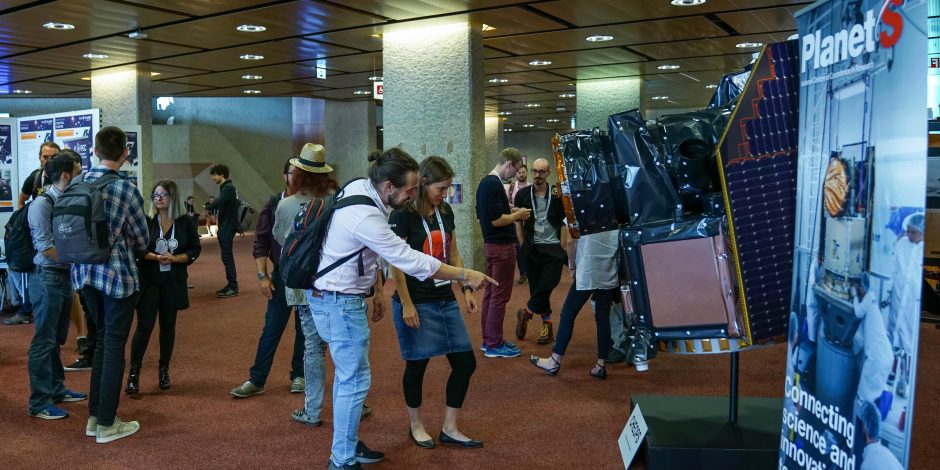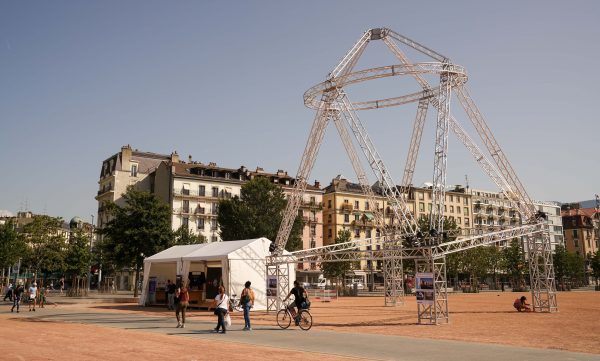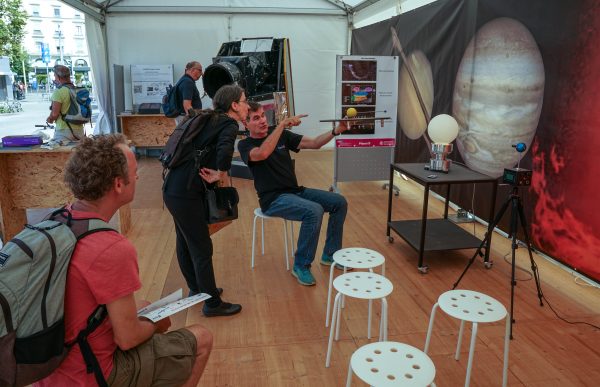EPSC-DPS 2019 in Geneva

About 1700 astronomers attended the planetology congress from 15th to 20th September organized jointly by the Europeans of the EPSC and the Americans of the DPS and which took place at the International Congress Center in Geneva.

The model of the VLT structure in Geneva. (Photo Sylviane Blum)
The Local Organizing Committee (LOC) partly funded by PlanetS, wanted the holding of this historic congress for the city of Geneva to be shared partly by the population of Geneva and therefore decided to set up an exhibition related to research on exoplanets. The main idea was to explain to the public the latest developments in this field of research and to show two emblematic instruments used by Swiss astronomers, the Very Large Telescope in Chile and the satellite CHEOPS. To get a better idea of what these two instruments represent, the Department of Astronomy of the University of Geneva has made models on a 1:1 scale.
The location chosen was the plain of Plainpalais, which is not only a busy place to cross between the city centre, the University and the RTS, but also a place reserved for the fruit and vegetable market and the flea market. The Plain, as it is called by the Genevans, forms a 600m x 200m diamond completely open, which makes it an ideal place for the presentation of the VLT by day as by night since the latter was lit until one o’ clock in the morning.

Pierre Bratschi of PlanetS explains how exoplanets are detected. (Photo Sylviane Blum)
PlanetS members took turns from 8am to 8pm throughout the week to animate the exhibition and answer questions from the public intrigued by this strange structure and by the CHEOPS satellite. “Is that the real one? When does it leave? Is it to find an alternative planet? “Is it the Chilean telescope?”, questions that reflected the curiosity of people. CHEOPS and the VLT also attracted a lot of media who were also surprised by the size of the two instruments. As for the two plaques on which the nearly 3000 children’s drawings are engraved, they were presented for the first time to the public, who could examine the drawings with a magnifying glass. “It’s a wonderful and very original idea to motivate children” was the most common comment.
The exhibition was therefore of great interest mainly during market days and at the end of the day, as the exceptionally mild weather encouraged both discovery and walking. Following their visit, some class teachers returned with their pupils, mostly interested and attentive children.
Meanwhile at the CICG and under the same sun, participants in the EPSC-DPS congress could elaborate their menu among the 54 sessions proposed by the scientific program. In addition to the sessions and conferences, four press briefings were organized to report on the progress of some space missions, including CHEOPS. Willy Benz, Kate Isaak (ESA), David Ehrenreich, Ravit Helled and Michel Mayor were on hand to present the mission in the context of exoplanet research as well as the 1:1 scale model of the satellite, indeed, if the “Geneva” model was on the Plainpalais plain, the Bernese model had made the journey to be presented to the conference.

Michel Mayor, Kate Isaak, Willy Benz, Ravit Helled and David Ehrenreich (f.l.t.r.) at a press briefing in Geneva. (Photo Sylviane Blum)
A little bit over 1700 participants from 52 countries attended the conference with Swiss researchers representing a solid 6% of the contingent. The scientific program was divided into five different programs for a total of 54 sessions: terrestrial planets (15), Outer planet systems (4), Missions, instrumentations, techniques (5), Small bodies – comets, KBOs, rings, asteroids, meteorites, dust – (11), Exoplanets and Origins (12) and Outreach, diversity (7). The total number of contributions was 1045 oral presentations and 790 posters.
Overall the conference was a success. A big thank you to all the conference assistants from PlanetS who helped during the week to make Geneva the world centre for Planetary sciences. (PB)
Image gallery

